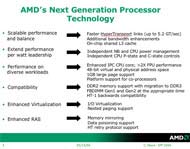 |
| AMD’s new chip architecture construction project. (Photo: AMD) |
This architecture, known as Next Generation Processor Technology, aims to improve design, enhance performance, and reduce power consumption for the current Opteron, Turion, and Athlon 64 chip lines.
“We are not just focusing on changing the core design every year; we are aiming for a larger strategy: the overall system performance“, emphasized Chuck Moore, a senior leader at AMD.
The processors based on AMD’s new architecture, expected to debut in 2007, will feature four cores and high-speed HyperTransport I/O technology. The recently completed HyperTransport 3.0 version can perform 5.2 billion data transfers per second.
One of the most significant changes is the cache — the integrated memory within the processor for quick data access. Current AMD chips have 2 caches per core. In the future, each core will still have 2 dedicated caches but may share an additional third cache to reduce processing time.
AMD utilizes DDR2 and DDR3 memory chip technology, while Intel is leaning towards the FB-DIMM standard. However, the world’s second-largest processor manufacturer believes that FB-DIMM technology generates more heat.
Conversely, Intel claims that desktop, mobile, and server processors based on the new chip architecture (Core Microarchitecture) — Merom, Conroe, and Woodcrest — will offer over 20% higher performance compared to AMD products.
Although not comparing each point directly, Chuck Moore asserts that AMD’s processors are already capable of surpassing their competitors. “Just by comparing performance and power consumption, it is clear to everyone that there are significant differences“, Moore stated.
P.T.


















































